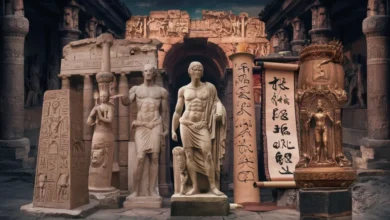Ancient Artz: A Timeless Journey Through Human Creativity

This expression, captured in what we now term Ancient Artz, serves as a fascinating window into the lives and minds of our ancestors. From mysterious cave paintings to intricately designed pottery and towering stone sculptures, ancient artz not only reflect cultural identity but also offer insights into the evolution of societies across the world. We’ll explore the enduring beauty, meaning, and influence of ancient artz, examining how these early masterpieces continue to inspire and inform the modern world.
Defining Ancient Artz
The term Ancient Artz refers to artworks and creative expressions produced by early civilizations, typically predating the Middle Ages. While it encompasses a broad range of periods and styles, ancient artz usually includes cave paintings, sculptures, pottery, architecture, jewelry, and textiles created by cultures such as Ancient Egypt, Mesopotamia, Greece, Rome, the Indus Valley, China, and the Americas. It was a tool for storytelling, a means of preserving history, and a way to honor deities and ancestors.
Origins and Early Examples
Some of the earliest known forms of ancient artz date back over 40,000 years. The cave paintings of Lascaux in France and Altamira in Spain are among the most famous prehistoric art sites. These intricate depictions of animals, human figures, and abstract symbols reveal the creative instincts of Paleolithic humans and hint at early spiritual or ritualistic beliefs.
As humans transitioned from nomadic tribes to settled agricultural societies, their artistic endeavors became more sophisticated. The Venus figurines — small sculptures representing the female form — are among the earliest examples of symbolic art, thought to signify fertility or goddess worship.
Ancient Artz Across Cultures
1. Ancient Egyptian Art
Perhaps one of the most instantly recognizable forms of ancient artz comes from Egypt. Characterized by its highly stylized and symbolic nature, Egyptian art adorned temples, tombs, and monuments. From the massive pyramids of Giza to intricate hieroglyphics and the iconic bust of Queen Nefertiti, these creations were deeply entwined with religion and the afterlife.
2. Mesopotamian Art
Often called the cradle of civilization, Mesopotamia produced some of the earliest known forms of written language and artistic expression. Ziggurats, cylinder seals, and detailed reliefs showcase the region’s achievements in architecture and sculpture.
3. Ancient Greek and Roman Art
Ancient Greece gave birth to naturalistic sculpture, perfecting the human form in marble and bronze. Statues like the Venus de Milo and Discobolus reflect ideals of beauty and balance. The Romans later built on Greek traditions, excelling in realistic portraiture, mosaics, and monumental architecture such as the Colosseum and Pantheon.
4. Asian Artz Traditions
In China, ancient artz include stunning bronzes, jade carvings, and the world-famous Terracotta Army of Emperor Qin Shi Huang. Meanwhile, Indian art from the Indus Valley civilization reveals sophisticated urban planning, pottery, and statuary, with later Hindu and Buddhist influences evident in temple carvings and religious iconography.
5. Indigenous Art of the Americas
From the Mayan and Aztec civilizations to the mound-building cultures of North America, indigenous peoples created complex artworks, including pyramids, textiles, pottery, and murals, often centered around cosmology, nature, and ancestral worship.
Symbolism and Purpose
What unites all these varied expressions of ancient artz is their deep symbolic meaning. Art was not created merely for aesthetic pleasure but served practical and spiritual functions:
-
Religious Worship: Many ancient artworks depict gods, goddesses, and mythological tales, used in rituals and to communicate with the divine.
-
Historical Record: Murals, carvings, and scrolls recorded important events, conquests, and royal lineages.
-
Social Identity: Artistic styles, motifs, and materials signified class, profession, or tribal affiliation.
-
Burial and Afterlife Practices: Tomb paintings, statues, and grave goods ensured safe passage and comfort in the afterlife.
Legacy and Influence
The influence of ancient artz resonates even today. Modern artists often draw inspiration from classical forms, mythological subjects, and ancient techniques. Museums and archaeological sites preserve these treasures, offering invaluable lessons about resilience, creativity, and the shared human experience.
Read More: Phoenix Suns vs Timberwolves Match Player Stats
Conclusion
Ancient Artz represents more than mere decoration — it is a testament to humanity’s innate desire to communicate, record, and transcend the ordinary. These timeless creations connect us with our ancestors, revealing the universality of artistic expression across cultures and epochs. As we continue to uncover and study these ancient masterpieces, we gain a deeper appreciation for the rich tapestry of human history and the enduring power of art.



